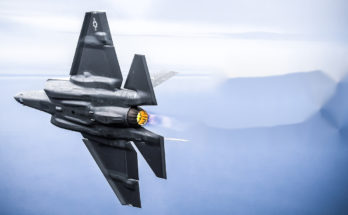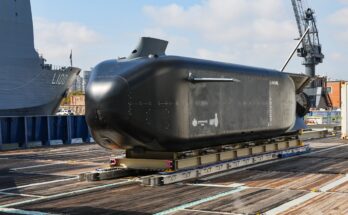by Markus Elken, Defense Analyst, Forecast International.

Boeing CH-47F. Image – The Boeing Co
Boeing’s CH-47 Chinook, in service since the Vietnam War, is currently the U.S. Army’s only heavy-lift cargo helicopter. With such a long and active service record, the CH-47 has seen its fair share of retrofit and upgrade programs, the most recent being the D-to-F Service Life Extension Program (SLEP). The first CH-47F prototype flew nearly two decades ago, in 2001, and the Army has been remanufacturing CH-47Ds to the F configuration and building new-production CH-47Fs ever since. As of mid-2019, the Army had taken delivery of more than 460 out of a planned 475 Block I CH-47Fs. The Block I upgrade, which is edging ever-nearer to completion, was not, however, intended to be the final evolution of the CH-47F, at least not according to the FY19 DoD budget. The CH-47 Block I to Block II program, which was to be funded at $881.2 million (including training and support) from FY21-FY23 per the FY19 budget, had been removed from FY20-FY24 spending plans as of early 2019. Here’s what we know about the status of the Chinook’s Block II upgrade program.
According to the FY20 budget, the Block I CH-47D-to-F SLEP ran up a total cost of roughly $10.1 billion through FY18. Block II, which would focus primarily on upgrading rotor blades, transmissions, and rotor heads, as well as an assortment of airframe strengthening efforts, was brought to the fore by the demands of counterinsurgency operations in regions like the Middle East. Increased lift capability (to carry the newly adopted, rather heavy JLTV) and improved performance in hot/high climates (think August para-rescue missions in the Afghan mountains) are the end goals of the Block II retrofit, but recent strategic trends are leaning away from the realm of counterinsurgency and the combating of irregular forces.
Enter the “Big Six.” Harkening back to the Reagan era of the “Big Five,” which saw the development and implementation of the M1 Abrams, AH-64 Apache, UH-60 Black Hawk, the Bradley Fighting Vehicle, and the first block of MIM-104 Patriot missile systems, current Army acquisition programs are highlighting the necessities of waging multidomain warfare against near-peer threats, such as China and Russia. Through 2024, the Army has identified six major programs as its highest priority, but for our purposes, we’ll be focusing mostly on just one: the Future Vertical Lift, or FVL, program.
While the Chinook has served admirably in ongoing operations in the Middle East and elsewhere, its capability in terms of penetrating modern air defense systems in contested airspace is limited, speed being a large contributing factor to the deficiency. The Bell V-280 Valor and Sikorsky/Boeing SB-1 Defiant, which serve as technology demonstrators for the FVL program, are both capable of flight speeds topping 250 ktas, with the former reportedly being designed for a cruising speed of 280 ktas . The CH-47, with its dual-engine, tandem-rotor configuration, is only capable of flight speeds to the tune of 170 ktas. Range is also a factor; the V-280 Valor boasts a reported effective combat range of 500-800 nautical miles, significantly larger than the Chinook’s 200-nautical-mile mission radius.
At its core, the CH-47 was never built for high speed or extreme range. The Chinook is a heavy-lift transport helicopter, capable of delivering over 10 tons of cargo or dozens of troops, something the FVL program’s Future Long-Range Assault Aircraft (FLRAA) isn’t specifically designed for. As such, the core competency of the Chinook is still in demand, and the Army has stated that the CH-47 will continue in its transport role for the Army over the next several decades. The decision to freeze the Block II upgrade, however, is drawing the ire of Boeing’s Philadelphia manufacturing plant and its roughly 300 component suppliers. If the funding for the Block I program serves as any indication, potentially billions in DoD funding dollars have been taken off the table, at least for now.
As it stands, the future of the CH-47F Block II upgrade rests almost entirely on the evolution of the FVL program. Secretary of Defense Mark Esper, former Secretary of the Army (2017-2019), has been open about the postponement of the upgrade. As reported in Breaking Defense, Esper stated that the decision to replace the HMMWV with the Joint Light Tactical Vehicle (JLTV), and the resultant need to lift it to the front that necessitated the development of the Block II upgrade, was made before former-Secretary of Defense James Mattis outlined the needs of a Russia/China-focused National Defense Strategy. “They (Block II and the JLTV) were in many ways designed for a different conflict,” Esper said. ” “[That] doesn’t mean we won’t use them in future conflicts, but now my emphasis has to be on…having aircraft that can penetrate Russian and Chinese air defenses [i.e., Future Vertical Lift]. We’re in this transition period, and some folks are caught in that transition.”
And quite a transition period it is. The JLTV has also been the recipient of large cuts, with Army Undersecretary Ryan McCarthy confirming back in March that the service would cut $800 million from the vehicle’s procurement program. Additionally, the longer the Army takes to make a decision, the more difficult and expensive it may become to execute the Block II upgrade.
There are, however, moves being made in the House and Senate to reinstate funding. In the FY20 House Authorization Report, the committee recommends an increase of $28 million in advance procurement funding for the aircraft (a total of $46.2 million), citing concerns about the heavy-lift rotorcraft industrial base as well as fleet readiness, while the House Appropriations committee requested that the Secretary of the Army restore funding for Block II when the FY21 budget request is submitted. Sentiments are similar in the Senate. Senate Authorization called for a hearing on the broader impacts of freezing the funding by October 1, 2019, and Senate Appropriations echoed the $28 million increase in advanced procurement funding, while also encouraging the Secretary of the Army to assess the increased costs, production issues, and industrial base risks inherent in delaying the acquisition program.
As funding continues to be funneled to the Big Six, it is likely Boeing and company will have to anticipate a decision on Block II as far as “two or three years” from now, according to Army Vice Chief of Staff Gen. James McConville, unless Congress decides to resume funding sooner. While foreign orders for the CH-47F and the similar Block II upgrades being made to SOCOM’s MH-47Gs will sustain at least part of Boeing’s production line, it will be difficult to cover the gap produced by freezing the planned modification of 473 aircraft. While periodic overhauls to the Chinook are to be expected as technologies advance and the aircraft continues service around the globe, a sweeping retrofit the scale of Block II is, for now, in limbo. FI anticipates a ruling on the future of the upgrade before 2024.
For 50 years, Forecast International intelligence reports have been the aerospace and defense industry standard for accurate research, analysis, and projections. Our experienced analysts compile, evaluate, and present accurate data for decision makers. FI's market research reports offer concise analysis of individual programs and identify market opportunities. Each report includes a program overview, detailed statistics, recent developments and a competitive analysis, culminating in production forecasts spanning 10 or 15 years. Let our market intelligence reports be a key part of reducing uncertainties and mastering your specific market and its growth potential. Find out more at www.forecastinternational.com




